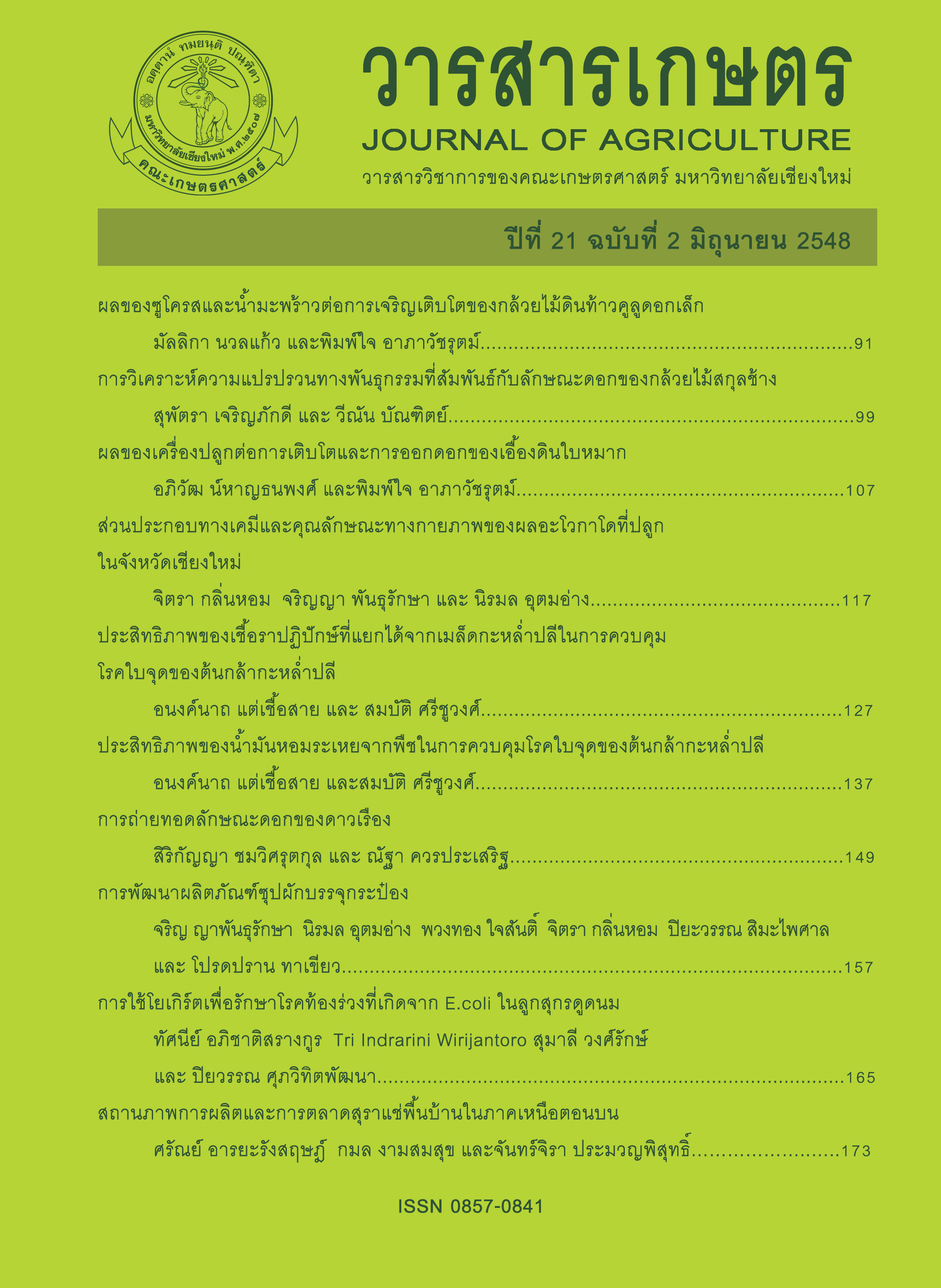การใช้โยเกิร์ตเพื่อรักษาโรคท้องร่วงที่เกิดจาก <I>E. coli </I> ในลูกสุกรดูดนม
Main Article Content
บทคัดย่อ
การศึกษาการใช้โยเกิร์ตเพื่อรักษาโรคท้องร่วงที่เกิดจากเชื้อ E. coli ในลูกสุกรดูดนม โดยใช้ลูกสุกรอายุ 1-14 วัน จำนวน 112 ตัว แบ่งลูกสุกรที่แสดงอาการท้องร่วงเป็น 5 กลุ่ม ได้แก่ 1) ลูกสุกร 26 ตัว รักษาด้วยยาปฏิชีวนะ (enrofloxacin) เป็นกลุ่มควบคุม 2) ลูกสุกร 15 ตัว รักษาด้วยโยเกิร์ตชนิดธรรมดายี่ห้อดัชชี่® 3) ลูกสุกร 23 ตัว รักษาด้วยโยเกิร์ตนมเปรี้ยวพร้อมดื่มยาคูลท์®4) ลูกสุกร 27 ตัว รักษาด้วยโยเกิร์ตที่ผลิตโดยใช้จุลินทรีย์จากโยเกิร์ตชนิดธรรมดายี่ห้อดัชชี่â เป็นหัวเชื้อ และ 5) ลูกสุกร 21 ตัว รักษาด้วยโยเกิร์ตที่ผลิตจากเชื้อจุลินทรีย์บริสุทธิ์ โยเกิร์ตจะถูกป้อนให้ลูกสุกรวันละ 2 ครั้ง (เช้า-เย็น) ตั้งแต่วันแรกที่แสดงอาการท้องร่วงจนกว่าจะหายป่วยแต่ไม่เกิน 5 วัน โดยวันแรกให้ในปริมาณ 5 มิลลิลิตร/ตัว/ครั้ง วันที่ 2 ให้ 10 มิลลิลิตร/ตัว/ครั้ง และวันที่ 3-5 ให้ 15 มิลลิลิตร/ตัว/ครั้ง ส่วนยาปฏิชีวนะที่ใช้เป็นชนิดกรอกเข้าปากโดยให้ในขนาด 20 มิลลิกรัม/ตัว/ครั้ง วันละ 2 ครั้งเช่นกัน พบว่า ลูกสุกรที่ตอบสนองต่อการรักษาของทุกกลุ่มใช้เวลาในการรักษาเฉลี่ย 2.76 วัน จำนวนลูกสุกรที่หายป่วยในกลุ่มทดลองสูงกว่ากลุ่มควบคุมอย่างมีนัยสำคัญ (100, 93.33, 92.59 และ 86.96% ในกลุ่ม 5, 2, 4, และ 3 ตามลำดับ vs 80.77%ในกลุ่มควบคุม; P<0.05) ดังนั้นจึงสรุปได้ว่าสามารถใช้โยเกิร์ตเพื่อรักษาโรคท้องร่วงที่เกิดจากเชื้อ E. coli ในลูกสุกรดูดนมได้
Article Details
เอกสารอ้างอิง
กิจจา อุไรรงค์. 2530. แนวทางการวินิจฉัย รักษา และการควบคุมโรค. ภาควิชาศัลยศาสตร์ คณะสัตวแพทย-ศาสตร์ มหาวิทยาลัยเกษตรศาสตร์, นครปฐม. 348 หน้า.
อนุรักษ์ ขัติยะ. 2546. ผลของโยเกิร์ตที่ใช้รักษาโรคท้องร่วงจากเชื้อ E. coli ในลูกสุกร. ปัญหาพิเศษปริญญาตรี. ภาควิชาสัตวศาสตร์ คณะเกษตรศาสตร์ มหาวิทยาเชียงใหม่, เชียงใหม่. 34 หน้า.
Apichartsrungkoon, T., A. Khad-Tiya, S. Jaturasitha, N. Simasatitkul, U. Ter Meulen and T. Vearasilp. 2003. Effect of yoghurt on Collibacillosis treatment in piglets. p. 262. In: Proceedings of the Symposium on Technological and Institutional Innovation for Sustainable Rural Develoment. University of Gottingen, Germany.
Baum, C.L. and D.L. Harris. no date. Effect of feeding Lactobacillus to pigs infected with Salmonella typhimurium. (Online). Available: http://www.ipic. iastate.edu/reports/00swinereports/asl-687 pdf (October, 2004)
Hale, O.M. and G.L. Newton. 1979. Effects of a nonviable Lactobacillus species fermentation product on performance of pigs. J. Anim. Sci. 48: 770-775.
IDF. 1997. Dairy Starter Culture of Lactic Acid Bacteria (LAB) Standard of Identity. pp. 1-8. In: International IDF Standard no. 149A, Brussels.
Letellier A., S. Messier, L. Lessard and S. Quessy. 1999. Assessment of different treatments to reduce Salmonella in swine. pp. 321-325. In: Proceedings of the 3rd International Symposium on the Epidemiology and Control of Salmonella in Pork. Washington, D.C.
Mclntosh, B. 2001. Piglet scours. (Online). Available: http://www.dpi.qld.gov.au/pigs/4457.html (October, 2004)
Park, J.S., S.D. Carter, M.J. Rincker, R.W. Fent and S.E. Gilliland. 2001. Effects of Lactobacillus acidophilus L23 supplementation on growth performance of weanling pigs fed low-lactose diets. (Online). Available: http://www.ansi. okstate.edu/research/2001rr/42/42.htm (October, 2004)
Taylor, L., P. Gill and V. Bland. 2000. Efficiency of Lactobacillus reuteri in pre and post weaning pigs. (Online). Available: http://www.biogaia.sc/report 6.pdf.
Walstra, P., T.J. Geurts, A. Noomen, A. Jellema and M.A.J.S. van Bockel. 1999. Dairy Technology: Principles of Milk Properties and Processes. Marcel Dekker, Inc., New York. 727 pp.


